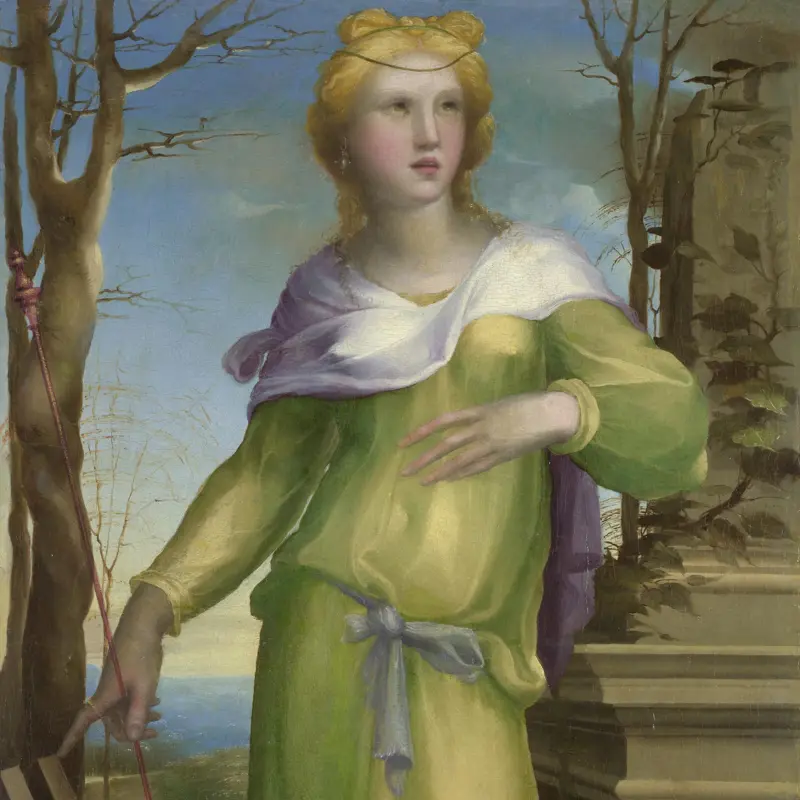Domenico Beccafumi, 'The Story of Papirius', mid-1520s
About the work
Overview
The Roman boy Papirius was sworn to secrecy by his father when he accompanied him to the Senate. When his mother asked him what had been discussed, Papirius lied and claimed they had debated whether it was better for a man to have two wives or a woman two husbands. Papirius’s mother rallied the matrons of Rome to petition the Senate that women might have two husbands. Their appeal was met by outrage. Papirius came forward to explain the confusion. Impressed by the boy’s wit, the Senate honoured him with the surname Praetextatus, after the toga praetexta worn by young boys.
Beccafumi represents the two episodes of the tale in a continuous narrative. On the far left, Papirius, wearing a short purple toga praetexta refuses to betray the senators. To the right, the matrons of Rome flock to the Senate, while at the centre of the hall Papirius is shown again explaining the misunderstanding. The panel probably once formed part of a series for the bedchamber of a palace in Siena.
Key facts
Details
- Full title
- The Story of Papirius
- Artist
- Domenico Beccafumi
- Artist dates
- 1484 - 1551
- Date made
- mid-1520s
- Medium and support
- oil on wood
- Dimensions
- 74 × 137.8 cm
- Acquisition credit
- Presented by George Salting, 1894
- Inventory number
- NG1430
- Location
- Room 6
- Collection
- Main Collection
- Previous owners
- Frame
- 16th-century Italian Frame
Provenance
Additional information
Text extracted from the ‘Provenance’ section of the catalogue entry in Cecil Gould, ‘National Gallery Catalogues: The Sixteenth Century Italian Schools’, London 1987; for further information, see the full catalogue entry.
Exhibition history
-
2014Building the Picture: Architecture in Italian Renaissance PaintingThe National Gallery (London)30 April 2014 - 21 September 2014
Bibliography
-
1894London, National Gallery Archive, NG17/5: Annual Report by the National Gallery of 1894: Bequests and Donations to the Gallery, 1894
-
1898National Gallery, Descriptive and Historical Catalogue of the Pictures in the National Gallery, with Biographical Notes of the Painters: Foreign Schools, 78th edn, London 1898
-
1901A. Venturi, Storia dell'arte italiana, 11 vols, Milan 1901
-
1933M. Gibellino-Krasceninnicowa, Il Beccafumi, Siena 1933
-
1935R. de Liphart Rathshoff, 'Un libro di schizzi di Domenico Beccafumi', Rivista d'arte, XVII, 1935, pp. 33-70, 161-200
-
1962Gould, Cecil, National Gallery Catalogues: The Sixteenth Century Italian Schools (excluding the Venetian), London 1962
-
1967D. Sanminiatelli, Domenico Beccafumi, Milan 1967
-
1977G. Briganti, L'opera completa del Beccafumi, Milan 1977
-
1987Gould, Cecil, National Gallery Catalogues: The Sixteenth Century Italian Schools, London 1987
-
1988G. Briganti, La pittura in Italia: Il Cinquecento, Milan 1988
-
1990K. Clark, 100 Details from Pictures in the National Gallery, 2nd edn, London 1990
-
1990F.S. Santoro and G. Agosti, Domenico Beccafumi e il suo tempo, (exh. cat. Pinacoteca Nazionale di Siena, Palazzo Bindi Sergardi, 16 June - 4 November 1990), Milan 1990
-
1994A. Thomas, An Illustrated Dictionary of Narrative Painting, London 1994
-
1995W.V. Harris, 'Un dipinto storico di Domenico Beccafumi alla National Gallery di Londra', Prospettiva, 78, 1995
-
1999L.P. Gnaccolini and L.T. Bardin, 'Liber Esther, multipliciter Christi et Ecclesiae sacramenta in mysterio continet', Arte Cristiana, LXXXVII/791, 1999, pp. 117-30
-
2001
C. Baker and T. Henry, The National Gallery: Complete Illustrated Catalogue, London 2001
About this record
If you know more about this work or have spotted an error, please contact us. Please note that exhibition histories are listed from 2009 onwards. Bibliographies may not be complete; more comprehensive information is available in the National Gallery Library.


